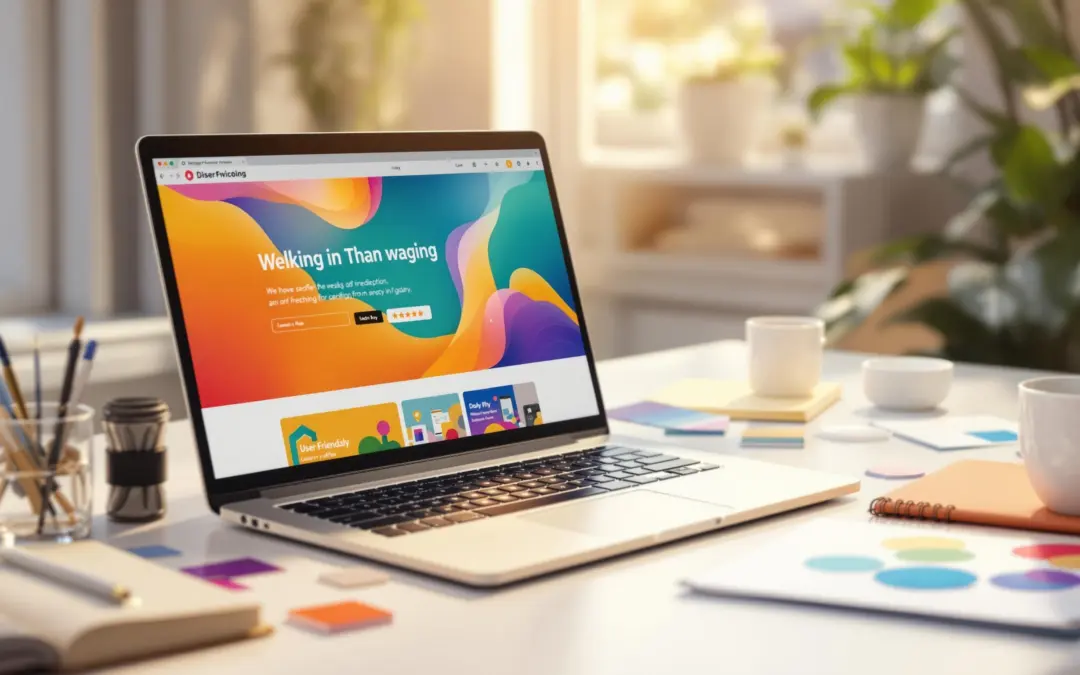94% of first impressions of your website are based on its design. A poorly designed site can lead to higher bounce rates, lost customers, and lower conversions. Here are the top issues and how to fix them:
- Poor Navigation: Confusing menus increase bounce rates by 50-100%. Fix by simplifying menus, adding search features, and optimizing for mobile.
- Slow Loading Times: 53% of users leave if a site takes more than 3 seconds to load. Optimize images, streamline code, and use tools like CDNs.
- Non-Responsive Mobile Design: 61% of users won’t return to a site that doesn’t work well on mobile. Start with mobile-first designs and test across devices.
- Messy Page Layouts: Cluttered pages drive users away. Use white space, clear headings, and simple designs.
- Poor Accessibility: 71% of users with disabilities leave inaccessible sites. Add alt text, improve contrast, and ensure keyboard navigation works.
Fixing these issues improves user experience, keeps visitors engaged, and boosts conversions. Start by testing your site’s navigation, speed, mobile usability, and accessibility today.
7 Common Web Design Mistakes and How to Fix Them
1. Hard-to-Use Navigation
Confusing navigation can seriously hurt your website’s performance. Sites with poor menus often face 50-100% higher bounce rates [1], 75% lower conversions [7], and see users spending 30-50% less time on the site [6].
1.1 Problem: Confusing Menu Structure
A poorly designed menu can frustrate users, leading to measurable losses:
- Bounce rates increase by 50-100% when users struggle to navigate [1].
- Time spent on-site drops by 30-50% [6].
- E-commerce platforms see 75% fewer conversions due to unclear navigation [7].
1.2 Fix: Create Simple, Clear Menus
Improving your site’s navigation can make a massive difference. Here’s how you can fix it:
1. Streamline Your Menu Structure
A cleaner menu can work wonders. For example, Spotify reduced its menu to just 7 items, which boosted user retention by 30% [5].
2. Implement Smart Search
Make it easy for users to find what they need. Netflix’s search-driven navigation cut content discovery time by 15% [5].
3. Use Clear Signposts
Help users know where they are and where they’re going with tools like:
- Breadcrumbs for tracking their location.
- Sticky menus for easy access while scrolling.
- Straightforward labels (e.g., use "Contact" instead of something vague like "Reach Hub").
4. Optimize for Mobile
Mobile users need special attention. Airbnb revamped its navigation with card-based menus, leading to better engagement and quicker bookings.
5. Regularly Test Navigation
Use tools like Hotjar to identify problem areas. Booking.com’s constant testing and tweaks led to steady conversion improvements.
With navigation sorted, it’s time to tackle issues with mobile design.
2. Poor Mobile Display
With 54.8% of web traffic coming from mobile devices, poor mobile design can seriously hurt your website’s performance. If your site isn’t optimized for mobile, you risk losing both user engagement and search engine rankings.
2.1 Problem: Broken Mobile Layouts
Mobile design flaws frustrate users and push them away. Common issues include:
- Text that’s too small, forcing users to zoom in constantly
- Overlapping elements, making buttons or links impossible to click
- Horizontal scrolling, which makes navigation awkward
- Hidden content, leaving key information inaccessible on smaller screens [1]
Plus, with Google’s mobile-first indexing, these problems can tank your search rankings [2].
2.2 Fix: Use Mobile-First Design Tools
Once you’ve improved navigation, tackle mobile layout issues with these steps:
- Start with Mobile-First Design: Build your site for mobile screens first, then scale up for desktops.
- Use Modern Development Tools: These tools can make a big difference:
| Tool Type | Popular Options | Benefits |
|---|---|---|
| CSS Frameworks | Bootstrap 5, Tailwind CSS | Create responsive layouts |
| Testing Platforms | BrowserStack, LambdaTest | Test across multiple devices |
| AI Design Assistants | Adobe Sensei, AIZI’s Divi AI | Automate layout adjustments |
- Learn from Success Stories: For example, Etsy‘s mobile-first redesign led to a 30% increase in conversions. Walmart simplified its mobile navigation and saw a 98% jump in mobile orders [9].
- Test and Optimize Regularly: Use Google’s Mobile-Friendly Test to check your site’s usability. Keep an eye on metrics in Google Analytics to catch and fix mobile issues quickly [5].
Even with a great mobile design, you’ll lose visitors if your site loads too slowly. We’ll tackle that problem next.
sbb-itb-037452d
3. Slow Loading Pages
A slow website doesn’t just frustrate visitors – it can cost you money. Google’s research shows that when a page’s load time increases from 1 to 3 seconds, bounce rates rise by 32% [2].
3.1 Problem: Heavy Images and Code
Several culprits can make your site sluggish:
- Unoptimized images: These can make up 50-90% of your page’s total weight.
- Bloated code: Things like unminified CSS/JavaScript files or render-blocking scripts can drag down speed.
- Server issues: Slow hosting or the absence of a content delivery network (CDN) can increase load times.
- Excessive HTTP requests: Every element on your page requires a separate server request, which adds up.
For context, pages that load in 2 seconds maintain a 9% bounce rate, while pages taking 5 seconds see bounce rates soar to 38% [4].
3.2 Fix: Speed Up Content Delivery
Want to speed things up? Here’s how:
-
Optimize Images
Compress images using tools like TinyPNG and switch to WebP format, which is 34% smaller than JPEGs [8]. Enable lazy loading and ensure image dimensions fit your design. -
Streamline Code
Minify CSS, JavaScript, and HTML files. Enable GZIP compression to shrink file transfer sizes by up to 70% [13]. Combine files to reduce HTTP requests and eliminate unused code or plugins. -
Upgrade Infrastructure
Consider these improvements:
| Optimization Type | Tool/Solution | Result |
|---|---|---|
| Content Delivery | Cloudflare CDN | Speeds up global content access |
| Caching | Browser Cache | Enhances repeat visits |
| Protocol | HTTP/2 | More efficient loading processes |
"Pages that load within 2 seconds have an average bounce rate of 9%, while pages that take 5 seconds to load see bounce rates spike to 38%" [4].
Use tools like Google PageSpeed Insights to monitor key metrics like Time to First Byte (TTFB) and Largest Contentful Paint (LCP).
Even if your site loads quickly, cluttered layouts can still drive users away – a challenge we’ll tackle next.
4. Messy Page Layout
Fast-loading pages are great, but a messy layout can still drive visitors away. People form opinions about your site in just 50 milliseconds [10], so every detail matters.
4.1 Problem: Overcrowded Pages
Cluttered pages hurt conversions. The common culprits?
- Visual Overload: Too many elements overwhelm users.
- Poor Content Hierarchy: Without structure, users struggle to find key information.
- Hidden Calls-to-Action: Important buttons or links get lost in the chaos.
4.2 Fix: Clean Up Design
Here’s proof that cleaning up works: In 2022, Shopify revamped its admin dashboard. By cutting UI elements by 30% and increasing white space by 25%, task completion jumped by 15%, and navigation-related support tickets dropped by 22%.
Want similar results? Focus on these layout tweaks:
| Design Element | How to Improve It |
|---|---|
| White Space | Add more margins and padding. |
| Visual Hierarchy | Use clear headings and subheadings. |
| Content Density | Remove unnecessary elements. |
| Tap-Friendly Targets | Make buttons easier to click. |
Practical tips for better layouts:
-
Highlight Key Information
Show the most important details first. Use expandable sections for less critical info to keep things tidy without hiding content. -
Refine Visual Elements
Did you know visuals are processed 60,000 times faster than text [11]? Make them count by:- Sticking to 2-3 fonts for consistency.
- Using a cohesive color scheme.
- Simplifying complex data with infographics.
- Applying a grid system for alignment.
-
Leverage AI Tools
Tools like Adobe Sensei can analyze patterns, Figma Auto Layout helps with spacing, and Hotjar tracks how users interact with your site.
Once your layout is polished, it’s time to tackle accessibility issues that might still be holding back user satisfaction.
5. Poor Accessibility
A clean layout means nothing if your design isn’t usable for everyone. With over 26% of U.S. adults living with disabilities [4], addressing accessibility is not just important – it’s essential for creating an inclusive experience.
5.1 Problem: Missing Accessibility Features
Accessibility issues are widespread. The WebAIM Million report highlights some of the most common problems found on home pages [12]:
| Issue Type | Percentage of Affected Pages |
|---|---|
| Insufficient color contrast | 86.4% |
| Missing image alt text | 60.6% |
| Empty links/buttons | 51.3% |
| Missing form input labels | 46.1% |
| Missing document language | 28.9% |
Legal cases like the Supreme Court’s ruling against Domino’s have also made it clear: digital accessibility is a legal obligation, not an option [3].
5.2 Fix: Add Accessibility Tools
Take a page from GOV.UK, which has set a strong example by using dark blue text with a 7.25:1 contrast ratio and ensuring all form fields are clearly labeled to meet WCAG guidelines.
Simple updates you can make right now:
- Add clear and descriptive alt text to all images.
- Make sure your site can be navigated using only a keyboard.
- Use a logical heading structure for better readability.
- Provide transcripts for audio and video content.
- Test your site with tools like WAVE or axe DevTools.
Why does this matter? Because 71% of users with disabilities will leave a website that’s difficult to use [10]. Fixing these issues not only brings your site into compliance but also creates a better experience for everyone.
Conclusion: Fix Design Issues for Better Results
Improving navigation, speed, layout, and accessibility can make a huge difference in keeping users engaged. Issues like confusing navigation, slow load times, cluttered designs, and lack of accessibility can drive users away – 88% of them won’t return after a bad experience [2].
Tools such as AIZI can simplify the process by optimizing images, suggesting accessible color palettes, and providing mobile-friendly templates. Its AI-powered recommendations ensure your site stays efficient and user-friendly.
These efforts pay off. For instance, Zappos’ 2022 mobile optimization initiative boosted conversions by 23% and cut bounce rates by 13% in just three months.
Quick steps to get started:
- Use PageSpeed Insights to check performance monthly
- Test your website across different devices
- Run accessibility checks using WAVE
- Monitor engagement metrics regularly



